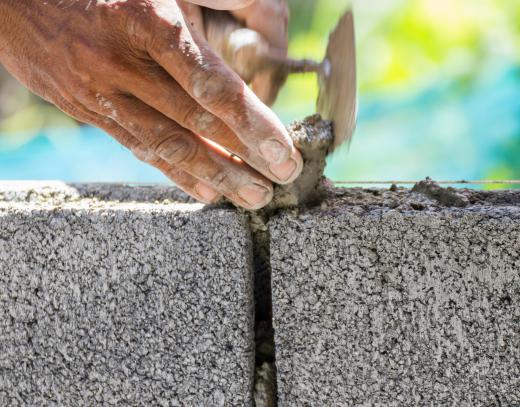Dry masonry is masonry which is put together without mortar. Technically, masonry consists of blocks which are attached to each other and supported with mortar, so one could question the use of the term “dry masonry,” but it is generally accepted. Numerous examples of this building technique can be found in ancient architecture, including some very impressive feats of construction engineering, and it continues to be used in a variety of settings all over the world today.
With dry masonry, the blocks in the project are held together with friction, instead of mortar. A number of different building materials can be used, with rough rock being a common building choice. The pieces may be trimmed and dressed or left relatively untreated, depending on the aesthetic goal for the structure being created. Also known as dry set masonry, this craft must be done by an experienced mason who is familiar with dry techniques, or it can be unsafe.

In dry masonry, the blocks are carefully stacked and arranged so that the blocks in the structure work to mutually support and hold each other in place. Even a simple project like a landscaping wall takes time and careful planning to ensure that the structure will be sound. Dry masonry can also be used to build supports for bridges and a wide variety of other projects. Entire structures are rarely built with this technique today, although examples of older dry masonry buildings can be seen in some areas of the world.

There are a number of reasons why people use this building technique. It can have a certain aesthetic appeal, and some people retain it because it is traditional. Walls for livestock pastures in some areas, for example, were historically made with dry set masonry and people retain the technique because it has historic value and they would like to make sure that the necessary skills are kept alive. Masons who know the technique can teach apprentices and provide them with tips based on their years of experience.
Using dry masonry can also promote drainage, which can be beneficial. Especially for things like garden walls, a dry set masonry wall which is well made can actually be more durable than a conventional masonry wall. People may also use the technique to create a wall which also serves as habitat for plants and animals, in which case the gaps in the wall will gradually fill in over time with colonizing plants.
Ever since she began contributing to the site several years ago, Mary has embraced the exciting challenge of being a About Mechanics researcher and writer. Mary has a liberal arts degree from Goddard College and spends her free time reading, cooking, and exploring the great outdoors.

